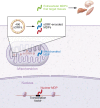Mitochondria-derived peptides in aging and healthspan
- PMID: 35499074
- PMCID: PMC9057581
- DOI: 10.1172/JCI158449
Mitochondria-derived peptides in aging and healthspan
Abstract
The mechanisms that explain mitochondrial dysfunction in aging and healthspan continue to be studied, but one element has been unexplored: microproteins. Small open reading frames in circular mitochondria DNA can encode multiple microproteins, called mitochondria-derived peptides (MDPs). Currently, eight MDPs have been published: humanin, MOTS-c, and SHLPs 1-6. This Review describes recent advances in microprotein discovery with a focus on MDPs. It discusses what is currently known about MDPs in aging and how this new understanding could add to the way we understand age-related diseases including type 2 diabetes, cancer, and neurodegenerative diseases at the genomic, proteomic, and drug-development levels.
Conflict of interest statement
Figures


References
Publication types
MeSH terms
Substances
Grants and funding
LinkOut - more resources
Full Text Sources
Other Literature Sources
Medical

